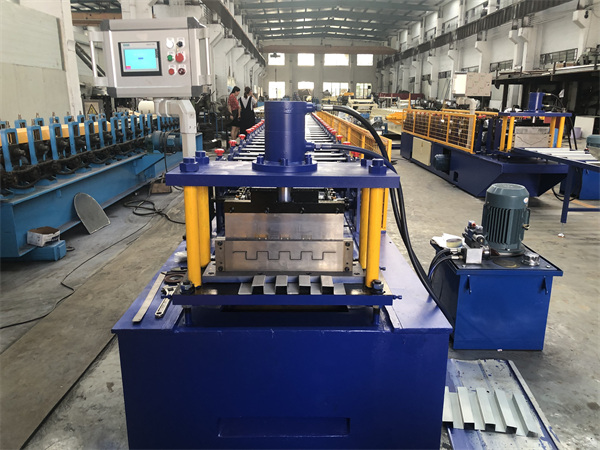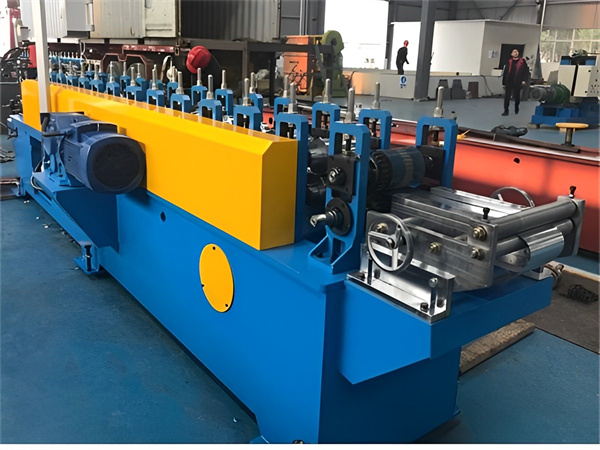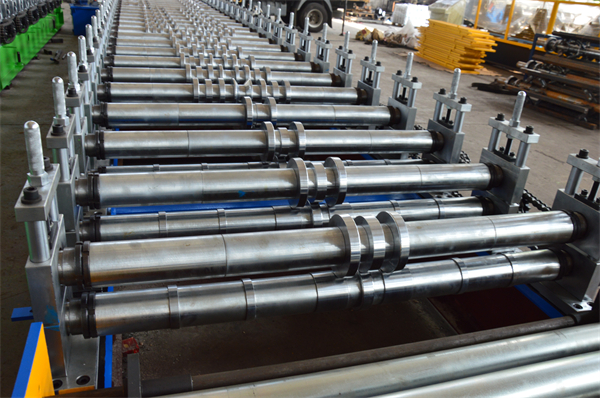Flashing roll forming machines are an essential equipment for manufacturers of metal building components like roofing, siding, panels, studs and more. This guide provides a comprehensive overview of different types of flashing roll forming machines, their key features, applications, specifications, suppliers, installation, operation, maintenance and more.
Overview of Flashing Roll Forming Machines
Flashing roll forming machines are used to form trim or flashing components from coil stock of various metals like steel, aluminum, copper etc. Flashing provides weather sealing, prevents moisture ingress and thermally insulates metal roofing and wall systems.
Roll formed flashing components include drip edges, rake trims, corner trims, head trims, jamb trims, sill trims and more. Flashing roll formers process flat strip stock into angled, v-shaped or box shaped profiles continuously.
Key benefits of using flashing roll formers:
- High production speeds up to 120 ft/min
- Capability to form complex and heavy gauge flashing up to 0.125 in thick
- Superior quality and consistency versus other methods
- Reduced material waste
- Lower labor requirements
- Ability to integrate with other downstream equipment
Types of Flashing Roll Forming Machines
There are two main types of flashing roll formers:
| Standalone Roll Formers | In-line Roll Formers |
|---|---|
| Configured as complete roll forming lines withdecoilers, pre-cutting, notching, punching, rolling stations, post-cutting and exit tables | Designed to integrate into existing manufacturing lines by removing decoiling and exit end functions |
| Require dedicated operator and floor space | Compact and flexible for tight spaces |
| Higher capacities and production | Lower capacities but seamless integration |
| Well-suited for high volume dedicated flashing production | Better for mixed products or lower volume flashing |

Key Components of Flashing Roll Formers
Flashing roll forming machines have the following key components in sequence:
- Decoiler: Feeds raw coil stock into the roll former
- Feeder: Controls stock flow into the forming stations
- Pre-cutting: Cuts sheet length prior to forming
- Punching & Notching: Punches holes or notches if needed
- Forming stations: Progressively forms the flashing profile
- Post-cutting: Cuts formed profile to length
- Exit table: Stacks or transfers finished product
Modern roll formers may also include pinch rolls for pulling stock through each station, servomotor-based controls, and integration of punching, notching, or embossing units between stations.
Flashing Profiles and Geometries
Common flashing profiles and geometries formed by flashing roll formers:
- 90° angles: For drip edges, corner flashings
- V-shaped: For rake trims, ridge caps, roof transitions
- Box-shaped: For parapet flashings, head flashings
- Complex angles & bends: For door/window jambs, sills, curved components
- Embossed patterns: For decorative finishes
Advanced 3D modeling and tooling design allows flashing roll formers to produce almost any geometry.
Key Specifications
Typical technical specifications of flashing roll formers include:
| Parameters | Range |
|---|---|
| Coil width capacity | 18 – 24 in |
| Finished part width | Up to 6 in |
| Material thickness | 26 – 120 gauge (0.025 – 0.125 in) |
| Metal types | Aluminum, steel, copper, other alloys |
| Forming stations | 10 – 16 |
| रफ़्तार | Up to 120 ft/min |
| Punches & notches | Up to 4 |
| Decoiler capacity | Up to 6000 lb |
| वज़न | 1500 – 4000 lb |
| Power supply | 208V or 480V, 3-Phase |
Applications and End Uses
Flashing roll formed on these machines are used in:
- Metal roofing systems
- Metal building exteriors and wall cladding
- Commercial roofing
- Agricultural building roofs
- Residential metal roofs
- Roof curbs and penetrations
- Sunrooms, canopies, patio covers
- Roofing for trailers, RVs
Key Benefits and Advantages
- High line speeds up to 120 ft/min maximizes output
- Ability to form complex and heavy gauge flashing up to 0.125 in thick expands capabilities
- Superior quality and consistency compared to other fabrication methods
- Advanced controls and quick change tooling improves changeovers
- Compact in-line models integrate seamlessly into production
- Low maintenance and operational costs versus other metalworking machinery
Limitations and Disadvantages
- Higher machine cost than alternate methods like brake pressing
- Requirement of high volume production to justify costs
- Fixed tooling limits profile flexibility compared to CNC folders
- Only processes coil stock, unable to use sheet or plate stock
- Limits on thickness and width capacity on smaller models

Costs and Pricing
Pricing for new flashing roll forming machines starts around $50,000 and goes up to $500,000 or more for high-end models with added automation and features. Average cost is $100,000 to $250,000.
| Machine Type | Approx. Price Range |
|---|---|
| Entry-level | $50,000 – $100,000 |
| Mid-range | $100,000 – $250,000 |
| High-end | $250,000 – $500,000 |
| Top-spec | $500,000+ |
Key Pricing Factors:
- लाइन की गति
- Width capacity
- Type and number of tooling stations
- Gauge capacity and metal type
- Automation features
- Brand and options
Used or rebuilt flashing roll formers are also available at 40-60% lower prices. This provides a more economical option for small manufacturers.
Leading Manufacturers and Suppliers
Some leading global suppliers of flashing roll forming machines include:
- Metform International
- Bradbury Group
- Formtek
- सैमको मशीनरी
- Form Process Engineering
- Gasparini
- Shanghai Metal Corporation
Selection Criteria for Suppliers:
- Reliable after sales support
- Quick delivery times
- Customization and flexibility
- Local representatives for service
- Training and Installation assistance
- Cost competitive pricing
- Robust construction and proven technology
Installation, Operation and Maintenance
- Flashing roll formers require a level concrete floor with proper foundations for installation.
- They need 3-Phase power connections and power drops per machine layout.
- Installation is best performed by manufacturer technicians.
- Operator training is provided for running and basic maintenance.
- Manuals cover safety, setup, controls, and troubleshooting procedures.
- Daily cleaning and maintenance improves uptime and longevity.
- Oil and lubricate moving components per schedule.
- Inspect and replace any worn or damaged parts.
- Schedule preventive maintenance and services for optimal performance.
Tips for Choosing the Right Flashing Roll Former
- Analyze current and future production needs and growth
- Determine suitable line speeds, width, and thickness capabilities
- Consider standalone versus in-line configuration
- Evaluate ease of tooling changeovers for flexibility
- Review automation features for lights-out production
- Select reputable manufacturer with local service and support
- Compare pricing and costs over lifetime
- Seek customized options based on requirements
Flashing Roll Former versus Brake Press: Pros and Cons Comparison
| Flashing Roll Former | Brake Press |
|---|---|
| Higher speeds up to 120 ft/min | Slower production rates |
| Continuous operation allows high volumes | Batch production limits output |
| Consistent quality and uniform profiles | More quality variation |
| Lower labor due to automation | Manual operation requires more labor |
| Fixed tooling provides repeatability | Lack of tooling consistency |
| Limited flexibility for profile changes | More profile flexibility |
| Efficient material usage and less scrap | Higher material waste |
| Lower cost per piece for long runs | Lower costs for small batches or prototyping |

निष्कर्ष
Flashing roll forming machines provide an efficient solution for high volume production of roofing, siding and wall flashing components. With speeds up to 120 ft/min, gauge capacities up to 0.125 in thick, and ability to form complex profiles, modern roll formers offer significant advantages over alternate methods. By understanding key specifications, configurations, pricing ranges and applications, metal component manufacturers can determine if investing in a flashing roll forming system will increase productivity, lower labor, and reduce per piece cost. Supplementing production with lower volume brake pressing provides flexibility to meet both high and low quantity requirements. With robust preventive maintenance and experienced operators, flashing roll formers can reliably produce components to meet roofing industry demand.
सामान्य प्रश्न
Q: What metals can be formed on a flashing roll former?
A: Most common metals are aluminum, galvanized steel, zinc steel, copper, and stainless steel. With proper tooling design, any ductile metal alloy coils can be formed.
Q: Can a flashing roll former make gutters and downspouts?
A: Yes, with the addition of specialized tooling and accessories for forming longitudinal profiles. Common gutter profiles like half-round, K-style, box gutters etc. can be produced at high speeds.
Q: What thickness of metal can a flashing roll former handle?
A: Standard flashing gauges from 26 gauge (0.025″) to around 18 gauge (0.050″) are commonly run. Heavy gauge capacity up to 0.125″ is also possible on some high-end models.
Q: How long does it take to changeover dies on a flashing roll former?
A: On machines with quick change tooling, profile changeover takes 15 minutes to one hour. Older models take 2-4 hours for changeovers.
Q: What factors determine the price of flashing roll forming machines?
A: Key factors are line speed, width capacity, number of forming stations, automation features, brand reputation, and overall robustness of construction. Prices range from $50,000 to $500,000.
Q: How much space do these machines require?
A: A typical standalone flashing roll former needs approximately 15-30 feet length by 10 feet width of floor space. In-line versions require less space.
Q: Is it better to buy new or used flashing roll forming equipment?
A: For maximum longevity, productivity and support, new machines are recommended. For smaller budgets, used and rebuilt machines provide good value at 40-60% lower cost.
